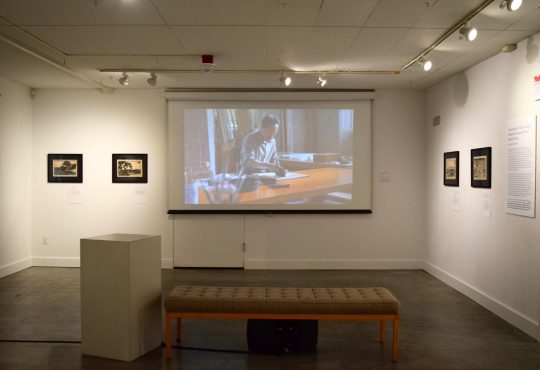Since its opening reception on Nov. 14, the Kittredge Gallery has hosted the 2012 Art Students Annual Exhibit. The exhibition presented the individual voices of Puget Sound students as much as it presented their artistic talents, a skill that is perhaps of greater importance.
One piece of artwork that especially made a statement was freshman Grace Best-Devereux’s “Kiskerätt,” a fishing net made of Swedish Fish.
“The assignment was to create a piece made of only one material,” Best-Devereux said. “I chose Swedish Fish because when I had visited Sweden two years ago, there was a lot of controversy on overfishing the Northern Oceans. I thought making a fishing net out of Swedish Fish would speak to the threat of overfishing.”
Another piece, a colorful oil painting called “The Sky’s Gone Out” by senior Valerie Cordova, displays Cordova’s talent for painting.
The artwork represents Cordova’s “favorite beach in Pacifica, Calif. for a landscape assignment in [her] painting class,” she explained.
“I wanted to create a sense of surrealism in terms of color but still have some realistic aspects,” Cordova said.
Junior Abbie Baldwin’s artwork, “Rectangle,” is “one print in a series of three that contain images of a dead crow that [she] photographed this summer.”
Baldwin’s inspiration for the print comes from a more personal place: her family.
“I was inspired by my grandpa, who passed away when I was eight,” Baldwin said. “He always felt a strong connection to crows and would often sit out front of his house and feed them. I’ve since taken on crows as a symbol for my paternal side of the family. The resulting print is a meditation on my feelings of family.”
These three very different pieces are only a few among the diverse artwork in the exhibit. The materials used in making the pieces also vary greatly from one to another: from paint to metal to pencil shavings, the exhibit does not fall short on creative variety.
While Best-Devereux’s use of Swedish Fish was meant to make a statement, Cordova and Baldwin chose their materials to make the artwork more aesthetically interesting.
“As a painting major,” Cordova said about “The Sky’s Gone Out,” “I have experimented with various types of paint. However, I feel I can create the most aesthetically pleasing pieces through oil due to how versatile the medium tends to be.”
On two of her works in the exhibit—“Rectangle” and “Cedar Bones”—Baldwin said that she “chose to use two different photo-based techniques in [her] prints, because they allow you to communicate the image with a much higher level of detail than would be possible from a drawing.”
Judging which pieces would be shown in the exhibit was Beverly Naidus, an Associate Professor of the Interdisciplinary Arts and Sciences Department of University of Washington, Tacoma.
“I decided to be a juror because I wanted to learn more about the work being created at local schools,” Naidus said.
According to Naidus, UW Tacoma students don’t often pursue art as a major. “Most of our students are art novices and don’t plan to be artists,” she said. “They are taking an art course because their major requires it.”
Some art students at Puget Sound seem more immersed in the idea of majoring in art. Best-Devereux said that she is “planning to pursue an art major, with an emphasis in sculpture.”
However, UW Tacoma’s art program focuses on being interdisciplinary.
“My courses are focused on themes,” Naidus said. These themes include Art in a Time of War and Body Image and Art.
“It’s a great way to teach beginners,” Naidus said. “It is more like facilitating a community-based arts practice than training students to be professional artists.”
Naidus also believes that art is especially important in today’s society.
“Students will be using their art skills,” she said, “to help communities create dialogue when there are polarizing conflicts, become visible and empowered and offer tools that allow others to share their stories with a larger world.”
Naidus’s book, Arts for Change: Teaching Outside the Frame, talks more about her opinions on art’s connection to society.
When judging Puget Sound students’ artwork for the exhibit, Naidus noticed that “there was quite a bit of work with strong formal or technical skills, but not as much work with a strong voice—work that told a story, expressed feelings, questioned an issue or explored intellectual terrain.
“I think it is not so difficult to help students find their voices if that becomes more of a priority than teaching a medium or a form,” Naidus continued.
Whether you see art as a showcase for talent or as a message to the world, any piece can be up to a thousand interpretations.
“You can use every word there is,” Best-Devereux said, “and you still won’t be able to evoke the essence of what the piece is. Art is interpretive; it’s seen differently by every person. To one person it will be beautiful, and the next will think it’s worthless. It’s very humbling.”
Perhaps that’s the beauty found in all art, including the art at the exhibit: no two people can look at it the same way.
Please visit the Puget Sound events calendar for more information on the Gallery and other events happening on campus.

